Genetics summary
Genetics summary
Genetics Summary
11-1 The Work of Gregor Mendelhapter 11 Introduction to Genetics
Every living thing inherits traits, or characteristics, from its
parents. People have long wondered how these traits are passed
from one generation to the next. Genetics is the scientific study
of heredity. Gregor Mendel did experiments with pea plants to study
inheritance. Pea plants are usually self-pollinating, meaning that
sperm cells fertilize egg cells in the same flower. The pea plants
he studied were true-breeding. True-breeding plants produce
offspring identical to themselves.
Mendel wanted seeds that inherited traits from two different
parent plants. He crossed two plants with different forms of the
same trait. A trait is a specific characteristic, such as height or seed
color. Mendel then grew plants from the seeds formed by each
cross. These plants were hybrids. Hybrids are the offspring of
crosses between parents with different traits. The first generation
of a cross is called the F1 generation. The second generation is
called F2, and so on. Each group of Mendel’s hybrid plants looked like only one of its parents. In one case, all of the offspring were tall. In another,
all of the offspring had yellow seeds. From these results, Mendel
drew two conclusions:
• Biological inheritance is determined by factors that are
passed from one generation to the next. These factors are
called genes. One gene with two different forms controlled
each trait. Each form of the gene is called an allele.
• Mendel also formed the principle of dominance, which
states that some alleles are dominant and others are
recessive. A living thing with a dominant allele, for a trait
always shows the trait. Recessive alleles are not seen if the
dominant allele is present.
Mendel wondered what happened to the recessive allele. To find
out, he let the F1 plants self-pollinate. Some of F2 plants showed
the recessive trait. The recessive alleles had not disappeared.
Instead, the dominant allele had masked them. From this, Mendel
concluded that when each F1 plant flowers and produces
gametes, or sex cells, the two alleles segregate, or separate, from
each other. As a result, each gamete carries only a single copy
of each gene. Therefore, each F1 plant produces two types of
gametes—those with the allele for tallness and those with the
allele for shortness.
11-2 Probability and Punnett Squares
Probability is the likelihood that a specific event will occur.
The principles of probability can be used to predict the
outcomes of genetic crosses. This is because the ways in which
alleles segregate is completely random. There are two important
points to remember with probabilities:
• Past outcomes do not affect future events.
• Probabilities predict the average outcome of many events.
They do not predict what will happen in a single event.
Therefore, the more trials there are, the closer the numbers
will get to the predicted values. Punnett squares are diagrams that model genetic crosses. Punnett squares can be used to predict and compare the genetic variations that will result from a cross. They help predict the
chances an offspring will be homozygous or heterozygous for
a trait.
• Organisms that have two identical alleles for a particular
trait are called homozygous.
• Organisms that have two different alleles for the same trait
are called heterozygous.
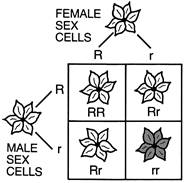
Punnett squares allow for the prediction of genotypes and phenotypes of possible offspring. The genotype is the genetic make of the individual. Phenotype is the physical appearance of the individual. In the punnett square above there are three different genotypes: RR, Rr, rr. There are two different phenotypes: White and grey.
11-3 Exploring Mendelian Genetics
Mendel wondered if genes that determine different traits affect
one another. He did an experiment to find out. Mendel found that
the gene for seed shape did not affect how the gene for seed color
sorted. He summarized his conclusions as the principle of independent
assortment.
The principle of independent assortment states that genes for different traits can segregate independently during the formation of gametes. Independent assortment helps account for the many genetic variations observed in plants, animals, and other organisms.
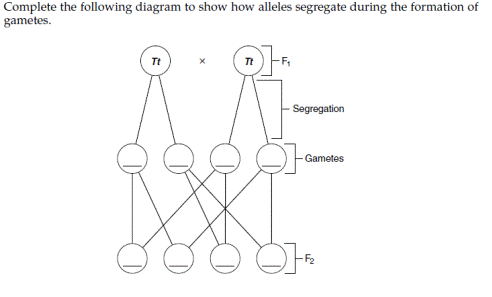
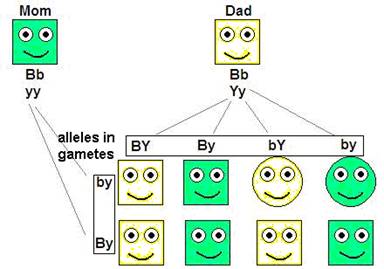
- What is genetics?
- What is a trait?
- What did Mendel call the F1 and F2?
- What two conclusions did Mendel make from his experiments?
- What is a gene?
- What is an allele?
- What is different about dominant and recessive alleles?
- What are gametes?
- What happens to the two alleles for the same gene when the gametes are produced?
- What is probability?
- What are the two points to remember when using probability for genetics?
- How are punnette squares used?
- What does homozygous mean?
- What does heterozygous mean?
- What is a genotype?
- What is a phenotype?
- Draw a punnett square. White (R) is dominant to grey (r). Cross two plants that are heterozygous.
- From the punnett square you created, what would the genotypes of the offspring be?
- From the punnett square you created, what would the phenotypes of the offspring be?
- What is independent assortment?
- In the diagram, what was the genotype of “MOM”
- What gametes did “MOM” produce?
- What was the genotype of “DAD”?
- What gametes did “DAD”produce?
Purple is dominant to white. If a heterozygous purple flower is crossed with a white flower, what would be the
- Genotypic ratio of the offspring
- Phenotypic ratio of the offspring?
If long ears in dominant to short ears in rabbits, what percent of the offspring of two heterozygous would be
- Homozygous dominant
- Long ears
- Heterozygous
- Short ears
If smooth leaves is dominant to wrinkled, then what must be the genotypes of the two plants if one parent is smooth, the other is wrinkled, and all their offspring have smooth leaves?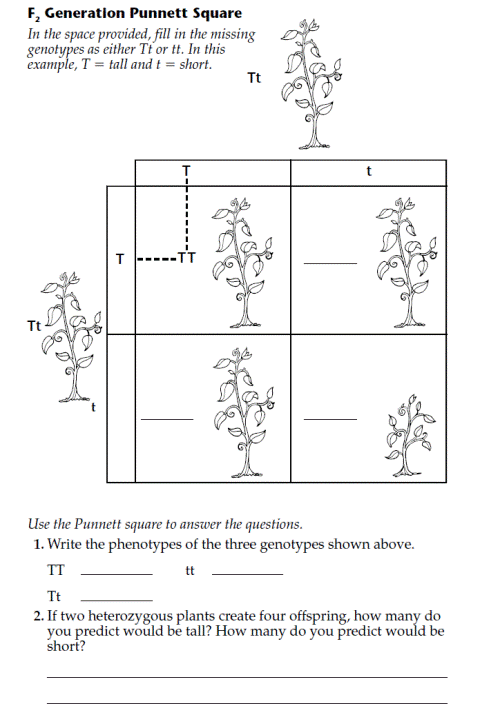
Beyond Mendelian Genetics:
Not all genes show simple patterns of dominant and recessive
alleles. Some alleles are neither dominant nor recessive, and
many traits are controlled by multiple alleles or multiple genes.
Some of these patterns are described below.
• In incomplete dominance, one allele is not completely
dominant over another. A red flower breeds with a white flower, all the offspring have pink flowers.
• In codominance, both alleles appear as part of the phenotype
of the heterozygous offspring. A black horse breeds with a white horse, the offspring come out with area of both black and white.
• Genes that have more than two alleles are said to have
multiple alleles. Human blood types are examples of multiple alleles. Humans have three alleles for their blood types, A, B and O .
• A single trait can be controlled by more than one gene.
These are called polygenic traits. There are up to eight different genes that causes the variety in human skin colors.
Genes do not control all characteristics. Some are due to interactions
between genes and the environment.
14–1 Human Heredity
In order to learn more about humans, biologists often use a
karyotype to analyze human chromosomes. A karyotype is a
picture of a cell’s chromosomes grouped in homologous pairs.
Humans have 46 chromosomes. Two of these, X and Y, are sex
chromosomes. Females have two X chromosomes (XX). Males
have one X and one Y chromosome (XY). The other 44 chromosomes
are known as autosomes. All human egg cells carry a
single X chromosome. Sperm cells carry either X or Y chromosomes.
Half of all sperm cells carry an X chromosome and half
carry a Y chromosome. This ensures that just about half of the
zygotes will be female and half will be male.
To study human inheritance, biologists use pedigree charts.
A pedigree chart shows relationships within a family. The
inheritance of a trait can be traced through the family. From this,
biologists may determine the genotypes of family members.
It is difficult to link an observed human trait with a specific
gene. Many human traits are polygenic, or controlled by many
genes. The environment also affects some traits.
The genes controlling blood type were among the first human
genes to be identified. A number of genes are responsible for blood
groups, but the two best known are the ABO blood groups and the
Rh blood group.
• Red blood cells can carry two antigens—A and B. Antigens
are molecules the immune system can recognize. A person
who has only antigen A has type A blood. A person who has
only antigen B has type B blood. A person who has both antigens
has type AB blood. A person who does not have either
antigen has type O blood. A single gene with three alleles
determines the ABO blood types.
• Red blood cells can also have the Rh antigen. People
with the Rh antigen are Rh positive. Those without it are
Rh negative. A single gene with two alleles determines
the Rh blood group.
There are many human genetic disorders. Some, including
PKU and Tay-Sachs disease are caused by recessive alleles.
Individuals must inherit a recessive allele from each parent. For a recessive disorder to occur, an individual must receive two recessive alleles, one from each parent. Other disorders, such as Huntington’s disease, are caused by a dominant allele. Huntington’s disease is expressed in any person who has the allele. So for a dominant disorder to show up in an individual, only a single dominant allele needs to be present. Still other disorders, such as sickle cell disease, are caused by a codominant allele.
Scientists are starting to learn which changes in the DNA
sequence cause certain genetic disorders. Sometimes, a small
change in the DNA of a single gene affects the structure of a
protein and causes a serious genetic disorder. This is the case
with cystic fibrosis and sickle cell disease.
14–2 Human Chromosomes
Genes on the X and Y chromosomes are said to be sex-linked.
They are inherited in a different pattern than are genes on
autosomes. Most sex-linked disorders are carried on the X chromosome. Males have just one X chromosome. Thus all X-linked alleles are expressed in males, even if they are recessive. Some examples of sex-linked disorders are colorblindness and hemophilia.
Most of the time, the mechanisms that separate chromosomes
in meiosis work well, but sometimes errors happen. The most
common error during meiosis is nondisjunction. Nondisjunction
is the failure of chromosomes to separate properly during meiosis.
If nondisjunction occurs, abnormal numbers of chromosomes
may find their way into gametes, and a disorder of chromosome
numbers may result.
• Down syndrome is an example of autosomal nondisjunction.
In this disorder, there is an extra copy of chromosome 21.
• Nondisjunction can also occur in sex chromosomes. Turner’s
syndrome and Klinefelter’s syndrome are two examples.
- Describe incomplete dominance?
- Give an example.
- Describe codominance?
- Give an example
- What is multiple alleles?
- Give an example
- What are polygenic traits?
- Give an example.
- What is a karyotype?
- How many chromosomes do humans have?
- What are the sex chromosomes?
- What sex chromosomes do females have?
- What sex chromosomes do males have?
- What are the autosomes?
- What do ALL human eggs carry?
- What is different about human sperm?
- What are antigens?
- What makes a person have type A blood?
- What makes a person have type B blood?
- What must happen for a recessive human disorder to be shown?
- What must happen for a dominant human disorder to be shown?
- What is a sex-linked trait?
- What chromosome do most sex-linked occur on?
- Why do males show sex-linked traits more often than females?
- What is nondisjunction?
- What causes Down sydrome?
A rooster with gray feathers is mated with a hen of the same phenotype. Among their offspring, 15 chicks are grey, 6 are black, and 8 are white.
- What is the simplest explanation for the inheritance of color in the chicks?
- What offspring would you expect from the mating of a grey rooster and a black hen?
Hemophilia is a sex-linked recessive gene.
- If a carrier female marries a normal male, what are the chances of their sons being normal?
- What are the chances of their sons being a carrier? Why?
Color-blind is a sex-linked recessive trait. A color-blind woman and a man with normal vision have a son.
- What is the probability that their first son will be color blind?
- What are the chances their daughter will be color blind?
In horses, Black (B) is dominant, White (b) is recessive. How is it possible that a black horse and white horse has colts that have both black and white patches?
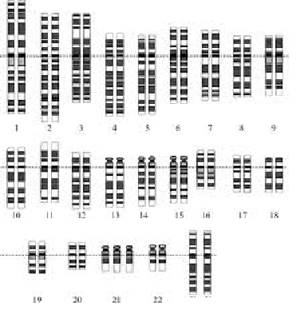
In the Karyotype above, Circle the sex chromosomes, and circle the disorder if there is one?
Circle the correct statememt below that describes the karyotype.
Normal Female Normal Male
Female with disorder Male with disorder
Which chromosome numbers are the autosomes?
11-4 Meiosis
Living things inherit a single copy of each gene from each parent.
These copies are separated when gametes form. The process in
which this happens is called meiosis. Meiosis is a process in
which the number of chromosomes per cell is divided in half
through the separation of homologous chromosomes in a
diploid cell.
• Acell that has both sets of homologous chromosomes is said
to be diploid. Diploid means “two sets.”
• Gametes have half the number of chromosomes as their
parent cells. Cells that have only one set of chromosomes are
said to be haploid. Gametes are genetically different from
the parent cell and from one another.
Before meiosis begins, cells undergo DNA replication forming
duplicate chromosomes. Meiosis then occurs in two stages.
Meiosis I:
• Two cells form.
• Each cell has sets of chromosomes and alleles that are
different from each other and from the original cell.
Meiosis II:
• The cells divide again, but this time the DNA is not
copied first.
• Four daughter cells form.
• Each daughter cell contains half the number of chromosomes
as the original cell.
One of the most significant events of meiosis happens during Prophase I. Homologous chromosomes, the two chromosomes that have the same genes at the same physical locations on the chromosomes, pair up next to each other. The chromosomes cross over each other, are cut and reconnect. This allows for an exchange of the alleles and produces new combinations of the genes on the chromosomes.
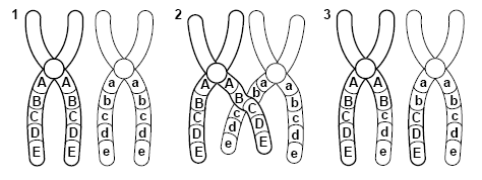
Each chromosome is now genetically different from the others.
Although they sound the same, meiosis and mitosis are different.
Mitosis makes two identical cells. These cells are exactly like the
parent cell. Meiosis, however, forms four cells. Each cell has
only half the number of chromosomes as the parent cell. The
cells are also genetically different from one another.
Questions:
- What happens to genes during meiosis?
- Define meiosis?
- What does diploid mean?
- What does haploid mean?
- What events happen during Meiosis I?
- What events happen during Meiosis II?
- What makes two chromosomes homologous?
- What is a crossover?
- How does crossing over change the chromosomes?
- Describe the cells after MITOSIS.
- Describe the cells after MEIOSIS
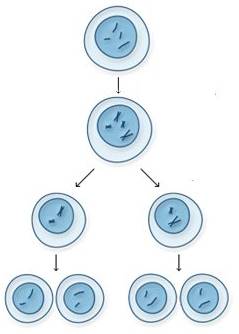
On the diagram above, label the following terms where they apply: Some terms may be found in the same locations.
Haploid, Meiosis I, Meiosis II, diploid, DNA Replication, Gametes, n, 2n, Chromosomes
Source: http://www.wuhsd.org/site/handlers/filedownload.ashx?moduleinstanceid=11917&dataid=27998&FileName=genetics%20summary.doc
Web site to visit: http://www.wuhsd.org
Author of the text: not indicated on the source document of the above text
OBJECTIVES:
1. Define the term genetics.
2. Distinguish between a gene and a chromosome, and state how many of each humans possess.
- State what the abbreviation DNA stands for and give the function(s) of this macromolecule.
- Explain the following process: DNA (gene) ---> messenger RNA —>Protein
- List several functions that proteins serve and state which proteins are the most important.
- Define the term mutation and discuss at least three results that may occur due to a mutation.
- Explain what is meant by the term sexual reproduction.
- Distinguish between gametes and somatic cells in terms of their genetic makeup.
- Name the cell that results from fertilization of gametes and give its genetic makeup.
- Define the term meiosis and explain its significance.
- Explain what is represented in a human karyotype.
- Define the term homologous chromosomes, and explain what happens between homologous chromosomes during Prophase I of meiosis.
- Distinguish between autosomes and sex chromosomes, and state how many pairs of each humans possess.
- Define the term allele, and give an example that illustrates the distinction between a gene and an allele.
- Distinguish between a dominant and recessive allele of a gene pair and give an example of each.
- State the genetic makeup of an individual who is homozygous for a trait versus one who is heterozygous for a trait, both in words and using typical letters.
- 17. Explain the difference between the genotype and phenotype of a trait.
-
- 18. Illustrate a Punnett square and explain why it is used.
- 19. Given a similar problem to those below, be able to express the results both genotypically and phenotypically:
- a. Brown eyes are dominant over blue eyes. If an individual who is homozygous dominant for eye color is crossed with a blue-eyed individual, what are the expected results of their offspring?
b. Widow’s peak is dominant over straight hairline. If an individual who is heterozygous for hairline is crossed with an individual with a straight hairline, what are the expected results of their offspring?
- 20. List the three major modes of inheritance and name a disease that results from each.
- 21. Given a similar problem to those below, be able to express the results both genotypically and phenotypically:
- a. Cystic fibrosis follows autosomal recessive inheritance. If parents have a child afflicted with CF, what are the chances that their next child will be afflicted with the disease?
b. Huntington’s Disease follows autosomal dominant inheritance. If a normal individual and a person carrying the HD allele become pregnant, what are the chances that this child will be afflicted with the disease?
- 22. Explain how sex is determined in humans.
- 23. Discuss the characteristics of sex-linked traits and name a disease that is transmitted in this fashion.
- 24. Define the term aneuploidy, explain how it may occur, and name the most common condition that results from aneuploidy in humans.
25. Define the term genomics and name the key difference between genomics and genetics.
- 26. Name the tests that can be performed prenatally to determine many genetic disorders.
- 27. Explain why genetic counseling would be useful for some couples.
- 28. Define the term gene therapy and discuss its significance in treating human disease.
-
- 29. Define and compare the terms:
- incomplete dominance and codominance;
- penetrance and expressivity;
- pleiotropy and heterogeneity;
- polygenic and mulitfactorial.
- THE EMERGING ROLE OF GENETICS AND GENOMEICS IN MEDICINE
Genetics, the study of inheritance, will play a critical role in future health care and medicine. The human genome project has triggered numerous genetic discoveries since its advent. New genetic information has allowed for the explanation of several physiological processes, both at the cellular & molecular level. In this chapter we will study the science of genetics and discuss inheritance patterns using specific diseases as examples. We will also discuss the new emerging science of genomics, which looks at the human body in terms of multiple, interacting genes.
WHAT IS GENETICS?
Genetics is the study of INHERITANCE AND VARIABILITY.
The term "genetics" is derived from the word "GENE".
- WHAT IS A GENE? (Review from Chapter 4)
- A gene codes for a particular heritable trait (or protein).
- i.e. blood type, hair color, eye color etc.
- Genes are carried on CHROMOSOMES that are composed of DNA (Deoxyribonucleic acid). See Fig 24.1, page 921.
- A GENE (composed of DNA) is the portion of a chromosome that codes for a particular heritable trait (or protein).
- More specifically, GENES TELL OUR CELLS WHICH PROTEINS TO MAKE.
- PROTEINS HAVE MANY IMPORTANT FUNCTIONS!!!!
- structure (Example = _____________________)
- transport (Example = _____________________)
- movement (Example = _____________________)
- chemical messengers (Example = _____________________)
- defense (Example = _____________________)
- ENZYMES.
- DNA HOLDS THE CODE FOR EVERY PROTEIN THAT MAKES US AND ALLOWS US TO FUNCTION!
I. THE EMERGING ROLE OF GENETICS AND GENOMEICS IN MEDICINE
A. GENETICS BACKGROUND
2. WHAT IS A GENE?
- If there is an error in the DNA code (i.e. in a gene), this is called a MUTATION.
- If a mutation occurs in a gene, the end-product, the protein will be altered or absent:
- may not be made at all. See Fig 4.26, page 126.
E1 E2 E3 E4



 A B C D E
A B C D E
When an enzyme is lacking from a metabolic pathway, childhood storage diseases result.
In Tay-Sachs, PKU, Niemin-Pick's.
- may have altered function. See Fig 24.2, page 922.
In cystic fibrosis & sickle-cell anemia
- may be produced in excess.
In epilepsy, where excess GABA leads to excess norepinephrine.
- HOW DO WE TRANSFER OUR GENES TO OUR OFFSPRING?
(Review from chapter 22)
- The genetic information of living organisms is DNA (deoxyribonucleic acid) that is carried on the genes of chromosomes.
- In humans, each somatic (body) cell is diploid, which means the cell contains 46 chromosomes or 23 pairs.
- Human sex cells or gametes, however, are haploid, which means the cell contains only 23 chromosomes.
- Meiosis is the type of cell division that results in gametes that possess half the chromosome number of the parent cell (i.e. meiosis reduces the chromosome number by one-half).
- Male sperm (haploid) = 23 chromosomes (1 set)
- Female egg (haploid) = 23 chromosomes (1 set)
- Fertilization
(zygote; diploid) = 46 chromosome (2 sets).
I. THE EMERGING ROLE OF GENETICS AND GENOMEICS IN MEDICINE
A. GENETICS BACKGROUND
- Development following Fertilization
- The zygote formed by fertilization will divide into 2, 4, 8, 16, 32, 64 ... billions of cells to make up a human organism, however the DNA/genes/chromosomes will be identical in every one of those billion cells.
- If a mutation exists in the zygote, it will also be in every one of those billion cells in the human organism.
- If a problem occurs during meiosis, a sperm or egg may have too many or too few chromosomes, and result in a zygote with more or less than 46 chromosomes:
- 24 egg + 23 sperm = 47 chromosome zygote
- Down's (trisomy 21),
- Patau's (trisomy 13),
- Edward's (trisomy 18 ).
- 23 egg + 22 sperm = 45 chromosome zygote
- THE HUMAN KARYOTYPE: See Fig 24.4, page 925.
-
- Chromosomes and Genes Come in Pairs
- As humans, most of our body cells contain 46 chromosomes:
- 23 (1 set) from mom;
- 23 (1 set) from dad.
- A map of these chromosomes is called a karyotype.
- Our chromosomes are paired.
- We possess 22 homologous pairs of autosomes:
- These chromosomes carry the genes for most of our traits (proteins).
- We possess 1 pair of sex chromosomes:
- Females have a homologous XX pair.
- Males have a non-homologous XY pair.
- See Fig 24.12, page 931.
- II. THE HUMAN KARYOTYPE: See Fig 24.4, page 925.
A. Chromosomes and Genes Come in Pairs
- The karyotype of a fetus can be obtained by a pre-natal test called an amniocentesis where any chromosomal abnormalities can be detected.
- A gene codes for a heritable trait (or protein).
- hair color
- eye color
- blood type
- Alleles are alternate forms of genes.
- The gene for eye color has several alleles. Two major alleles are:
- Some alleles are dominant over others:
- Brown is dominant over blue.
- The dominant allele brown is written as an upper case letter (B);
- The recessive allele blue is written as a lower case letter (b).
- We inherit one (1) allele of a gene from each parent and therefore have two (2) alleles for each gene.
- If we inherit identical alleles, we are said to be homozygous for the trait.
- BB = homozygous dominant;
- bb = homozygous recessive.
- If we inherit two different alleles, we are said to be heterozygous for the trait.
- The phenotype is the expressed trait.
- The genotype is the genetic makeup of the trait:
- BB or homozygous dominant
- Bb or heterozygous
- II. THE HUMAN KARYOTYPE: See Fig 24.4, page 925.
- B. Dominant and Recessive Inheritance
- If brown eyes are dominant over blue eyes, predict the offspring of a cross between two individuals who are heterozygous for eye color.
- Interpret given information: What are the genotypes and resulting cross of these two individuals?
- Individual 1 =_______(Bb); Individual 2 = _____(Bb).
- Therefore cross would be _______ x _______.
(Bb x Bb)
- What allele(s) would be present in each of the individuals' sex cells?
- Individual 1 = ½ ____(B) & ½ _____(b);
- Individual 2 = ½ ____(B) & ½ _____(b).
- Set up a Punnett Square illustrating the possible crosses
- Interpret the results of the cross:
- The genotypic ratio would be:
- one (1) homozygous dominant (BB) individual :
- two (2) heterozygous (Bb) individuals :
- one (1) homozygous recessive (bb) individual.
- The phenotypic ratio would be:
- three (3) individual with brown eyes:
- one (1) individual with blue eyes.
- II. THE HUMAN KARYOTYPE: See Fig 24.4, page 925.
B. Dominant and Recessive Inheritance
- In humans, widow's peak is dominant over straight hairline. Predict the offspring of the cross between an individual who is homozygous dominant for hairline, with an individual who is homozygous recessive for hairline.
- Interpret given information:
- Widow’s peak = W; Straight hairline = w.
- Therefore the cross is: _________ x ___________.
(WW) (ww)
- Determine alleles in sex cells:
- All of WW’s alleles would be _______(W);
- All of ww’s alleles would be _______ (w).
- Interpret results:
- Genotypic Ratio: All individuals are heterozygous for hairline.
- Phenotypic Ratio: All individuals have widow’s peaks.
II. THE HUMAN KARYOTYPE
- Whether a trait is dominant or recessive, autosomal or sex-linked is called its mode of inheritance.
- The mode of inheritance has important consequences in predicting the chance that offspring will inherit an illness or trait.
- Three important rules:
- Autosomal Conditions are equally likely to affect both sexes.
- Sex-linked characteristics affect males much more often than females.
- Recessive conditions are usually inherited from two healthy heterozygous parents (carriers).
- Recessive conditions "skip" generations.
- Dominant conditions are inherited by at least one affected parent.
- Dominant conditions do not skip generations.
- Example Using Cystic Fibrosis: See Fig 24.5, page 926.
- Autosomal Recessive Inheritance;
- Both parents are heterozygous (carriers); i.e. they have one normal & one mutant allele; genotype = + , cf
- What alleles would be present in the female’s eggs?
1/2 = ________(+) , 1/2 = _________(cf)
- What alleles would be present in the male’s sperm?
1/2 = ________(+) , 1/2 = _________(cf)
- What are the chances that parents who are heterozygous for cf will have an afflicted child?
|
+ |
cf |
+ |
+ + |
+ cf |
cf |
+ cf |
cf cf |
- Results: These parents have
- _____ (1/4) chance of having a normal child (+,+) ;
- ______ (½) chance of having a child who is carrier of CF (+, cf) ;
- _______ (1/4) chance of having a child with CF (cf, cf).
II. THE HUMAN KARYOTYPE
C. MODES OF INHERITANCE:
- Example Using Huntington Disease: See Fig 24.6, page 927.
- Autosomal Dominant Inheritance;
- Affected parent = + , HD
- Unaffected parent = + , +
- Affected parent: ½_____ (+), ½ _____ (HD);
- Unaffected parent: ½ _____ (+), ½ _____ (+).
- What are the chances that a male who carries the Huntington's gene & a normal female will have an afflicted child?
|
+ |
HD |
+ |
+ + |
+ HD |
+ |
+ + |
+ HD |
- Results: These parents have the chance of having
- ___________ (½) their offspring that carry the allele for Huntington disease and therefore those children will develop the disease during mid-life and
-
- ____________(½) their offspring who do not carry the HD allele and therefore will be normal.
II. THE HUMAN KARYOTYPE
C. MODES OF INHERITANCE:
- Example Using Sickle Cell Anemia (or disease) in which one of the four amino acid chains in hemoglobin is incorrect causing sickling of erythrocytes.
- Incomplete Dominant Inheritance.
- The heterozygous (carrier) parents express a moderate form of the disease; called sickle cell trait.
- What are the chances that a male with sickle cell trait & a normal female will have an afflicted child, either with sickle cell anemia or sickle cell trait.
- Male: HbA, HbS
- Female: HbA. HbA
- Sperm: 1/2 = ______( HbA), 1/2 = ______( HbS)
Eggs: 1/2 = ______( HbA), 1/2 = ______( HbA)
|
HbA |
HbS |
HbA |
HbA HbA |
HbA HbS |
HbA |
HbA HbA |
HbA HbS |
- Results: These parents have the chance of having
- _______ (½) their offspring that carry sickle cell trait,
- ________(½) their offspring of being normal.
-
-
- See Fig 24.7, page 928, which illustrates incomplete inheritance involved in plasma cholesterol levels.
II. THE HUMAN KARYOTYPE
C. MODES OF INHERITANCE:
7. Different Dominance Relationships
- Incomplete dominance
- Results if heterozygote exhibits a phenotype halfway between dominant and recessive
- Person has about half of a particular protein that a homozygous dominant person would have
- Codominant
- Results when both alleles are expressed
- Example is AB blood type
- GENE EXPRESSION - how a gene affects phenotype
Penetrance and Expressivity
- Penetrance – phenotype presentation
- Whether or not the allele is seen in phenotype
- Completely penetrant = all who have allele have trait
- Incompletely penetrant = only some with allele show trait
- Numerically, 50% penetrance = 50 out of 100 who have allele have trait
- Expressivity – how much the phenotype is expressed
- Sometimes variable intensity is seen in different people
- For example some people with polydactyly have 1 extra digit, some have 4 extra digits
Pleiotropy
- When a single genotype affects many phenotypes
- due to protein having many locations and functions
Genetic Heterogeneity
- When more that one genotype causes the same phenotype
- For example, many different clotting disorders (genotype) are known, but they all have the same symptoms (phenotype)
COMPLEX TRAITS
- Polygenic Traits
- Determined by more than one gene.
- Height, skin color, eye color are polygenic
- See Fig 24.8, page 929 and 24.9 page 930.
Multifactorial Traits
- Determined by more than one gene (polygenic) and environment.
- Height is Multifactorial because it is polygenic plus nutrition plays a role
- See Fig 24.8, page 929 and 24.9 page 930.
V. MATTERS OF SEX
- Sex Determination: See Fig 24.11, page 931.
- In sexually reproducing animals, two types of chromosomes exist:
- Most pairs are called autosomes which determine most traits;
- One pair represents the sex chromosomes, which determine sex of the individual.
- Female = XX;
- Male = XY. See Fig 24.14, page 935.
- Following gametogenesis (sex cell formation; meiosis):
- In females, the ova (gametes) contain 22 autosomes and the X sex chromosome. All ova contain the X chromosome.
XX
¯
X (ova)
-
- In males, the sperm contain 22 autosomes, but
- half the sperm carry the X sex chromosome and
- the other half of the sperm contain the Y sex chromosome:
XY
¯
X or Y (sperm)
- During fertilization, the chance of:
- an X sperm and the X ova fusing to produce a female (XX) is 50%;
- a Y sperm and the X ova fusing to produce a male (XY) is 50%.
V. MATTERS OF SEX
- Sex Chromosomes and Their Genes
Example Using Hemophilia in which a clotting factor is missing that leads to bleeding disorders.
- Traits transmitted on the X chromosome are said to be sex-linked (or X-linked).
- Males need only one copy of a mutant allele to possess the disorder; XaY.
- Females need two copies of the mutant allele to be affected (XaXa); however if they have one mutant allele, they are carriers of the disease (XaX0).
- What are the chances that a female hemophilia carrier and normal male will have a child afflicted with the disease?
-
- Genotypes of parents:
- Female = XHXh;
- Male = XhY.
-
- Alleles of parents:
- Female’s are ½ XH and ½ Xh;
- Males are ½ Xh; and ½ Y.
-
-
|
XH |
Xh |
Xh |
XH Xh |
Xh Xh |
Y |
XHY |
Xh Y |
- Results: These parents have the chance of having
- ______ (½) their female offspring as hemophilia carriers and
-
- _______ (½) their female offspring as normal, and the chance of having
-
- _______ (½) of their male offspring afflicted with hemophilia and
-
- _______ (½) their male offspring as normal.
V. MATTERS OF SEX
- Gender Effects on Phenotype
- Only tend to affect certain sex
- Reason that a woman doesn’t grow a thick beard, but her son’s can
- Traits that are dominant in one sex but recessive in the other
- Due to hormonal differences
- Reason that more men are bald than women
VI. CHROMOSOMAL DISORDERS
- Polyploidy = more than two sets of chromosomes.
-
- Triploid = three sets of chromosomes or 69 (rather than 46);
- results in death as embryo or fetus.
- Aneuploidy = missing one or having one extra chromosome.
- See Figure 24.14, page 935.
- Trisomy 21 = Down Syndrome:
- See Clinical Application 24.2 on pages 936.
-
- most common autosomal aneuploid event;
-
- Characteristics:
- short stature
- straight sparse hair
- protruding tongue; thick lips
- reflexes/muscle tone poor
- development slow
- warm, loving personalities
- enjoy art & music
-
- Intelligence varies greatly
- profound mental retardation to
- following simple directions to
- reading & using a computer
-
- Many physical problems:
- 50% die before 1st birthday
- kidney defects
- heart defects
- digestive blockage
- Child with Down's is 15 times more likely to develop leukemia.
- Those who live past 40, develop amyloid protein in their brains (similar to Alzheimer's).
-
- Likelihood of giving birth to a child with Down's increases drastically with maternal age. See Table 24A, page 936.
VII. GENETIC TESTING and GENETIC COUNSELING
See Fig 24.15, page 938 and Table 24.2, page 937.
- AMNIOCENTESIS
- indicated in women:
- over the age of 35,
- who have already given birth to a child with a chromosomal abnormality,
- whose family history (paternal included) shows any sign of genetic disease.
- performed after 14th week gestation;
- Needle is inserted into amnionic sac and 5ml of fluid containing fetal cells is extracted.
- Cells are analyzed by karyotyping.
- Useful in detecting many genetic disorders.
- 0.5% chance of miscarriage
- CHORIONIC VILLUS SAMPLING
- performed as early as 8 weeks gestation
- 1-2% spontaneous abortion rate
- involves obtaining and analyzing rare fetal cells in maternal circulation.
- These cells may be responsible for autoimmune disorders including scleroderma (see Chapter 16).
- Because of the unique ethical questions and dilemmas that can result from genetic testing, genetic counseling is highly recommended for couples during this time. A genetic counselor:
- obtains a complete family history.
- determines recurrence risks for certain conditions in specific relatives.
- provides information on the illness so families can make informed medical decisions.
- discusses available tests and costs.
- discusses options.
- GENE THERAPY
-
- Gene therapy corrects the genetic defect causing disease symptoms.
- Two types:
-
-
- alters all genes of individual
- must be performed on a fertilized egg or zygote
- not being performed in humans, but has shown some success in animal models.
-
- Nonheritable Gene Therapy
-
- targets affected cells (not all cells) of an afflicted individual
-
- Bone marrow transplants may be used to add an absent enzyme to particular blood cells (ADA deficiency);
- Aerosols may be used to treat cystic fibrosis patients by introducing a functional CFTR gene.
- Injection of certain proteins directly into tumors.
See Figure 24.17, page 942, which shows the many body locations where gene therapy is being used and for which diseases gene therapy has shown promise.
- Requirements for Approval of Clinical Trial for Gene Therapy
-
- Knowledge of defect and how it causes symptoms
- Animal model
- Success in human cells growing in vitro;
- Either the lack of alternate therapies or where existing therapies have not been successful;
- Experiments must be safe.
-
-
- Which cells should be treated?
- What proportion of the targeted cell population must be corrected to alleviate or halt progression of symptoms?
- Is overexpression of the therapeutic gene dangerous?
- If the engineered gene “escapes” and infiltrates other tissues, is there danger?
- How long will the affected cells function?
- Will the immune system attack the introduced cells?
See Clinical Application 24.3, pages 940 and 941, which discuss some successes and setbacks with gene therapy.
- GENOMICS AND A NEW VIEW OF ANATOMY AND PHYSIOLOGY
- The human genome consists of at least 40,000 protein-encoding genes.
- The human genome project has triggered numerous genetic discoveries since its advent.
- Knowing the human genome sequence has made it possible to view physiology at the microscopic level, as a complex interplay between gene functions.
- The science of genomics looks at the human body in terms of multiple, interacting genes, rather than the field of genetics which deals mostly with single genes.
Fig 24.3, page 923 views genomics at the whole body, cellular, and microscopic level.
- Introduction on page 920, which provides a look into the future of genetics and how DNA “chips” may be used to prevent and/or treat genetic disease.
-
- Clinical Application 24.1: “It’s all in the Genes”, page 924, which discusses several common human traits that are determined by a single gene.
-
- Figure 24.8, page 929, which illustrates the continuously varying nature of height.
-
- Figure 24.9, page 930, which illustrates variations in skin color using a model of three genes.
-
- Figure 24.10, page 930, which illustrates variations in eye color using a model of two genes with two alleles each.
-
- Figure 24.13, page 933, which illustrates pattern baldness as a “sex-influenced” trait.
Source: https://highered.mheducation.com/sites/dl/free/0072919329/65697/ch24.doc
Web site to visit: https://highered.mheducation.com
Author of the text: not indicated on the source document of the above text
If you are the author of the text above and you not agree to share your knowledge for teaching, research, scholarship (for fair use as indicated in the United States copyrigh low) please send us an e-mail and we will remove your text quickly.
Fair use is a limitation and exception to the exclusive right granted by copyright law to the author of a creative work. In United States copyright law, fair use is a doctrine that permits limited use of copyrighted material without acquiring permission from the rights holders. Examples of fair use include commentary, search engines, criticism, news reporting, research, teaching, library archiving and scholarship. It provides for the legal, unlicensed citation or incorporation of copyrighted material in another author's work under a four-factor balancing test. (source: http://en.wikipedia.org/wiki/Fair_use)
The information of medicine and health contained in the site are of a general nature and purpose which is purely informative and for this reason may not replace in any case, the council of a doctor or a qualified entity legally to the profession.
Genetics summary
Genetics summary
The following texts are the property of their respective authors and we thank them for giving us the opportunity to share for free to students, teachers and users of the Web their texts will used only for illustrative educational and scientific purposes only.
All the information in our site are given for nonprofit educational purposes
The information of medicine and health contained in the site are of a general nature and purpose which is purely informative and for this reason may not replace in any case, the council of a doctor or a qualified entity legally to the profession.
Genetics summary
www.riassuntini.com







![]()
![]()
![]()
![]() A B C D E
A B C D E